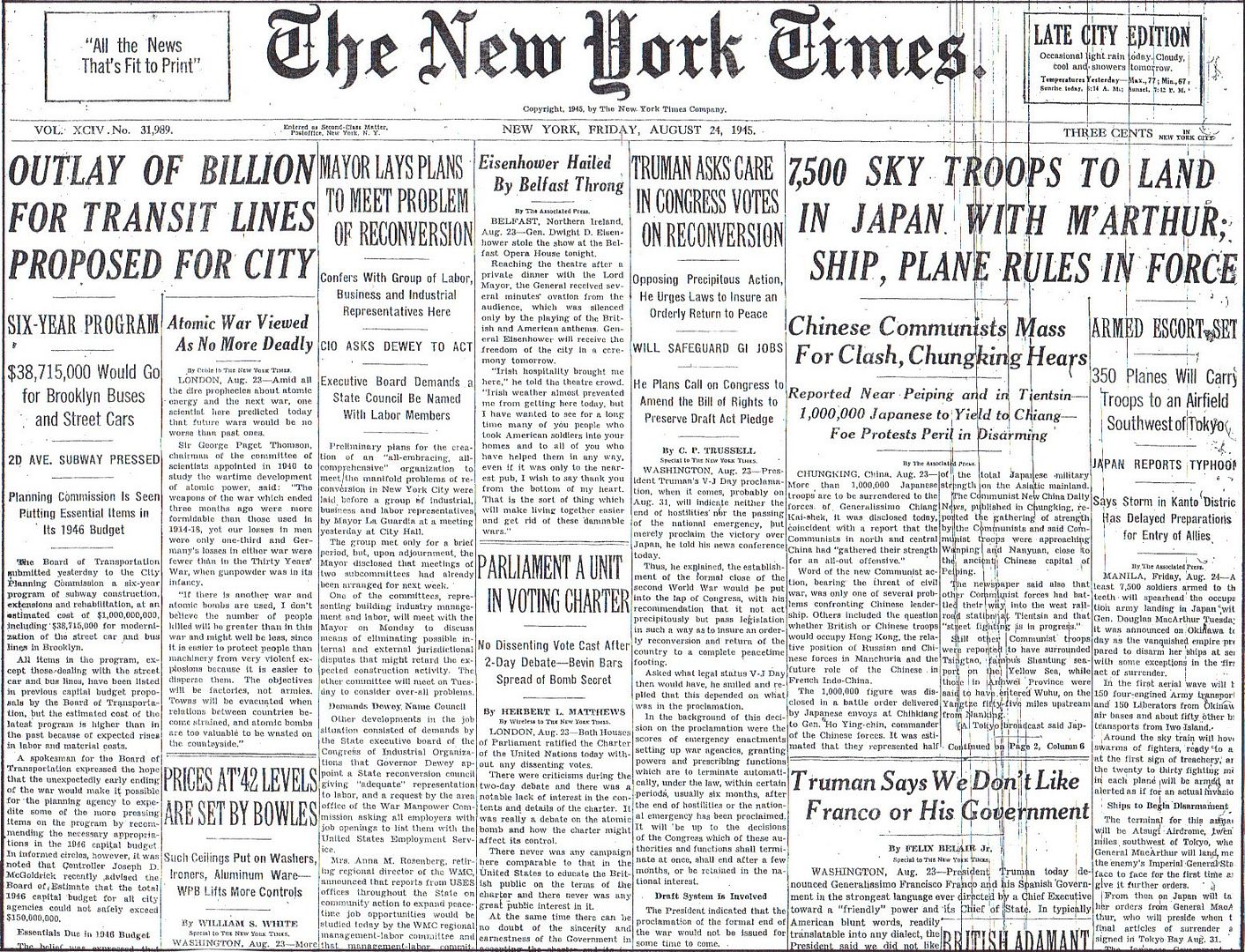
Posted on 08/24/2015 4:26:18 AM PDT by Homer_J_Simpson

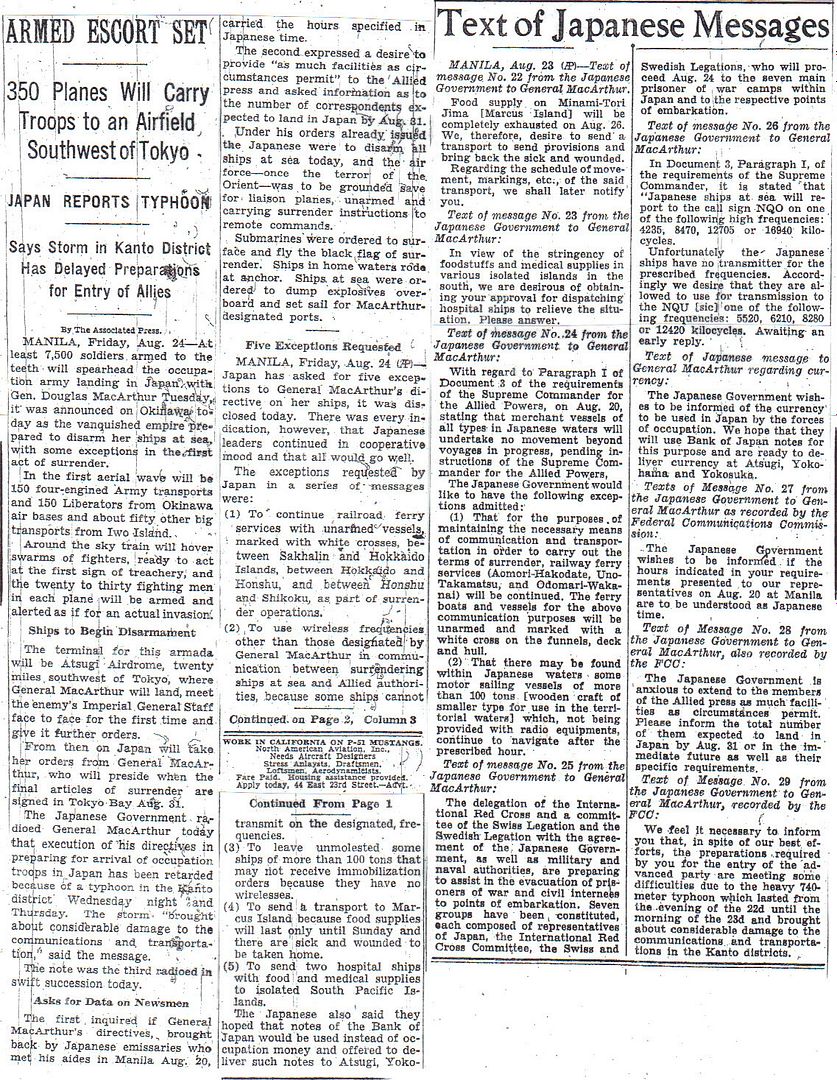
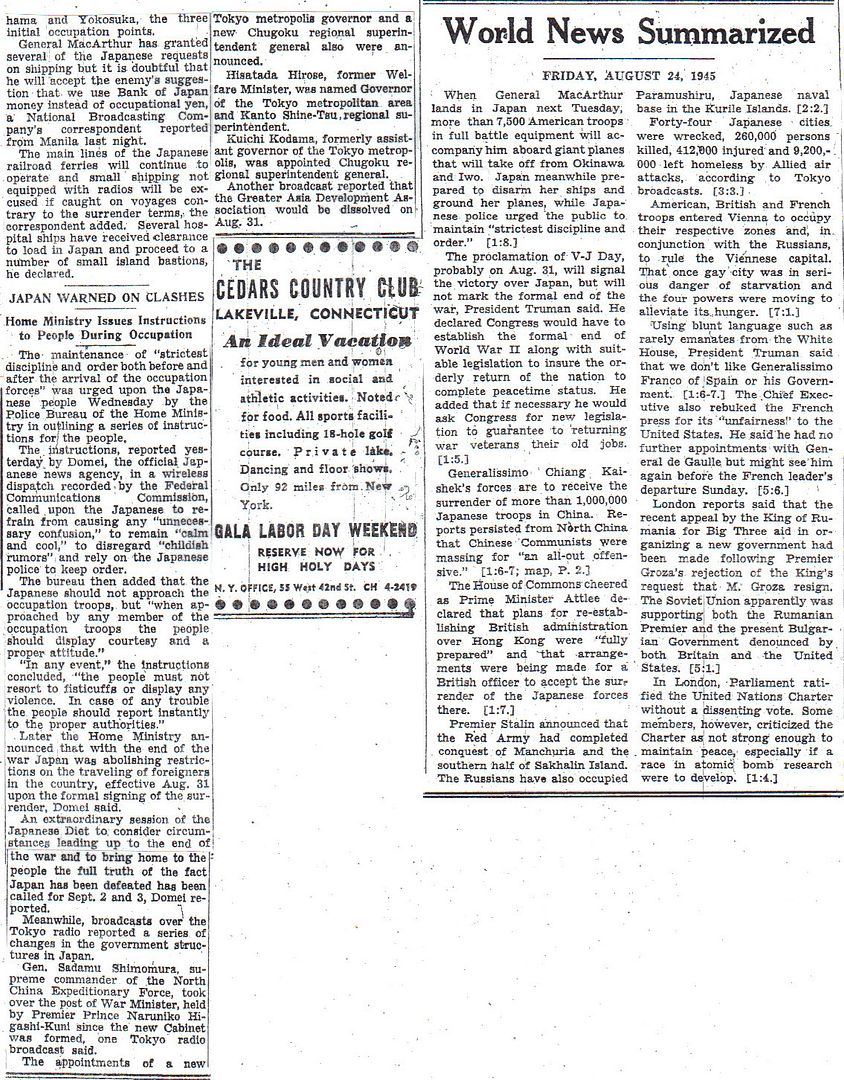
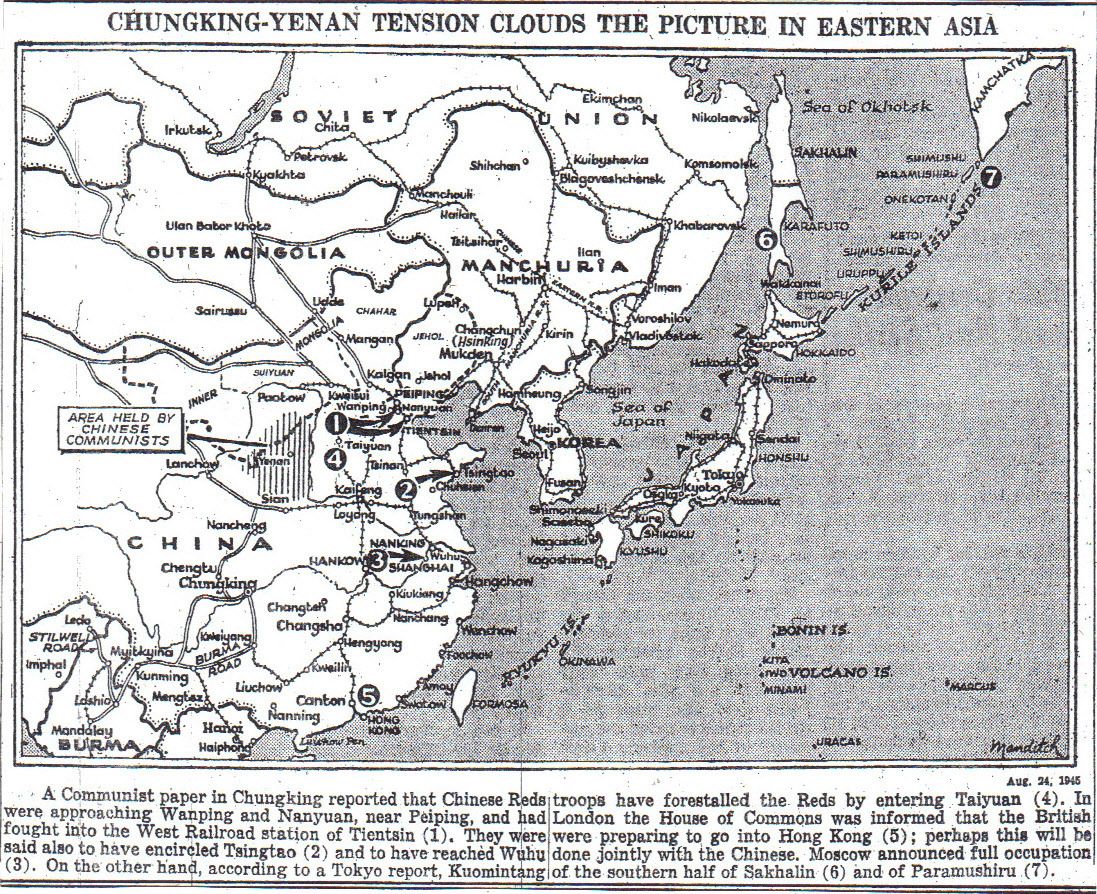
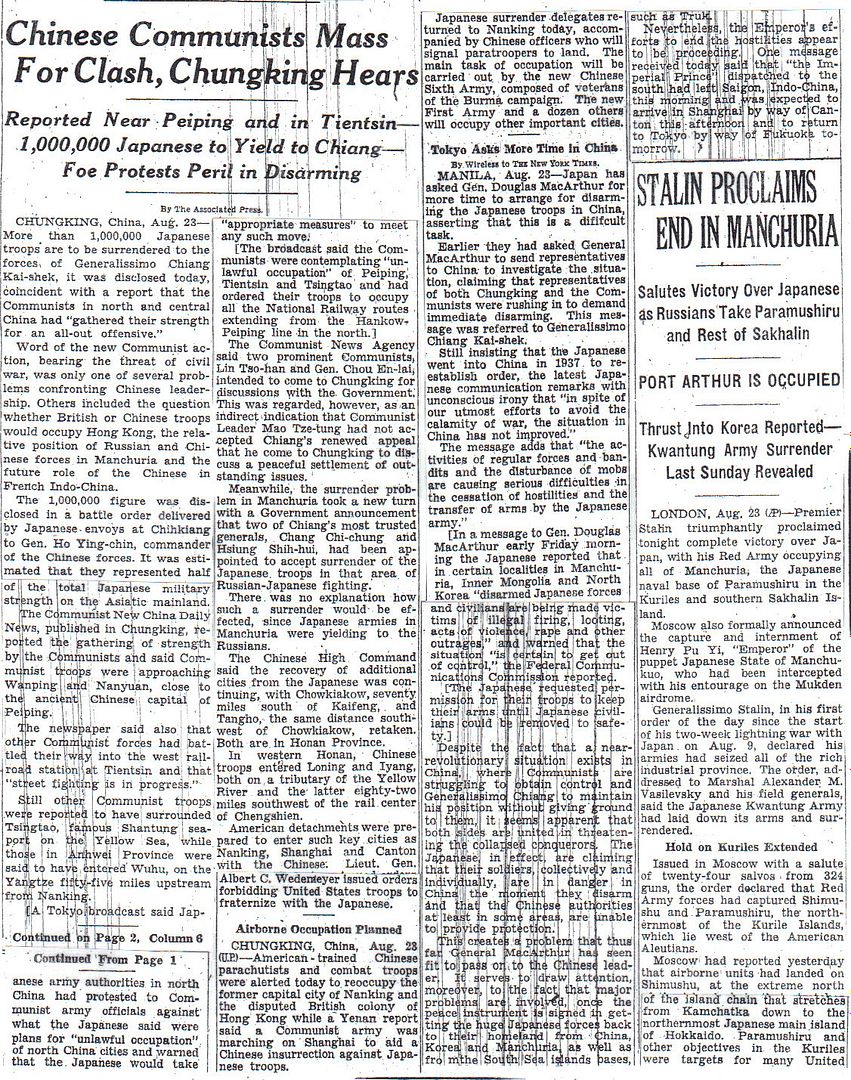
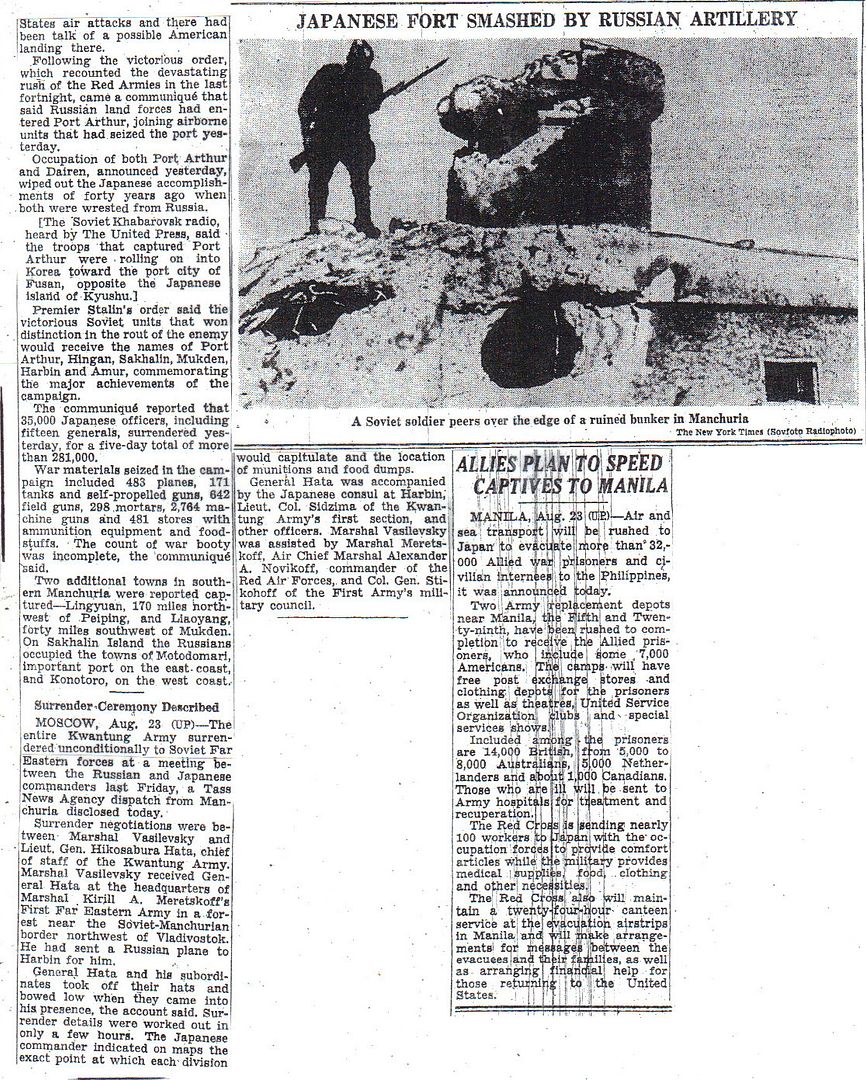
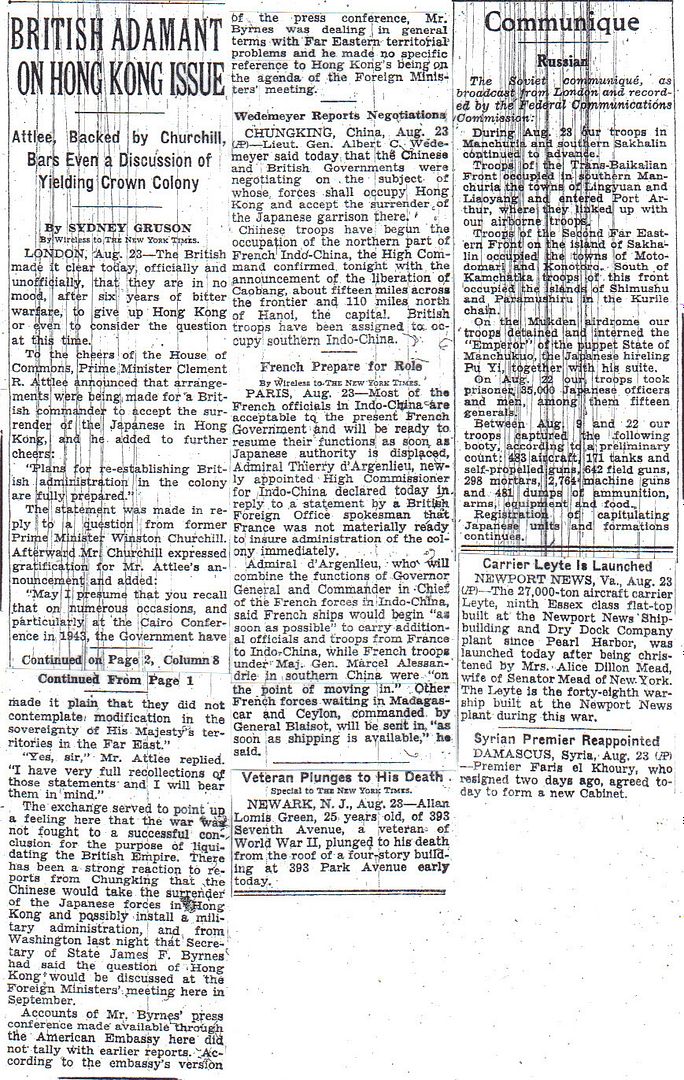
PTSD?
7,500 Sky Troops.
Typhoons Ruth and Susan both went through western Japan at this time, one after the other, which would have blocked any planes flying from Okinawa, Ie Shima, or Iwo Jima to Honshu. That probably set everyone back a few days, which would explain, among other things, why the surrender signing was on 9/2 rather than 8/31.
Incidentally, it will happen after HJS ends his course, but 30 planes flying 900 liberated POWs from Manila to Okinawa were downed by Typhoon Ursula, some time around 9/10; I don't know any more about the incident.
Veteran Plunges to His Death. Page 7.
https://progressivehistorians.wordpress.com/2007/10/06/ptsd-and-the-myth-of-ww-ii/
I had an uncle who was a paraplegic from Iwo Jima. He did everything, wheel chair basketball, hunting and fishing, worked jobs, invented a system so he could drive. Life was hard both before and after the war for him, but he was a hero to all the nephews.
As I get holder I experience some of the symptoms though I was never in the service. Life is hard sometimes but there is no doubt the war had an effect.
It is a COMPLEX thing. Some got stronger because of battle. In some, battle brought out what existed in their personality. In some cases battle caused it.
The reference says that only 35% saw battle.
In WWI many officers behind the line got shell shock. Interesting that in WWI it was thought that exploding shells caused a concussion in the brain, thus the confusion as to cause.
There are many reports that say that suicide among the military is no different than the rate in civilian population. But because it is military, it gets more attention?
I do not want to discount this. Reading the above and the images and experiences imprinted on young developing men had to leave a life time effect.
This doesn't necessarily mean the other 65% didn't "see" what the 35% "saw." Y'all remember my father was a radio mechanic working on the Superforts on Guam, so he was never in any of the battles. But the things he experienced--the Japanese soldiers who were still fighting on the island while he was there and what they did, the conditions of the bombers and those who flew in them, along with the soldiers coming back from the battles, and finally the trepidation on realizing his likely part in the seemingly inevitable invasion--all combined to affect his approach to postwar life, so that I could see it in him, a generation later.
Would it be safe to assume that the formal surrender on the Missouri got pushed back to the second of Sept. because of the weather?
The radio transmissions from the Japanese to MacArthur seem reasonable enough, dealing with the realities of the practicalities of fulfilling their end of things.
This made me think about the differences between the logistics of the surrenders of Germany and Japan. Germany surrendered in seven days after the death of Hitler, while Japan surrendered in 17 days after the rescript of Hirohito. I can think of three differences off the top of my head, and it would be interesting if others here would be willing to point out any others...
1) There wasn't much left to surrender by the time Hitler died; Germany was essentially overrun, so outside of the U-boats and a few Nazi units elsewhere, it wouldn't have taken long to get the surrender set up. By contrast, Japan still had a far-flung military presence, often without supply lines and without communication (remember, the last Japanese soldier surrendered in 1974), so it's not surprising that organizing the surrender would take longer.
2) By the beginning of May, there weren't many Nazi leaders left: Doenitz was the Fuhrer, but all the rest of the inner circle was either dead (Hitler, Goebbels) or heading for the hills (Himmler, Goering), so it was easy to point to Doenitz and make him make the decisions necessary. By contrast, all of Japan's leadership was fully involved and fully available, so it took the better part of a week to assemble a government that could surrender without the Emperor himself actually participating openly in the surrender, plus going through all the nemawashi of getting everyone on board. One of the effects of this, BTW, was that Japan's occupation went far more smoothly than Germany's--not only because of the lack of Soviet involvement (thank God), but because with extremely few exceptions, the Japanese co-operated with the occupation from beginning to end.
3) August is typhoon month along the ring of fire, just as it is hurricane month in the Atlantic, and there seem to have been more typhoons than usual in 1945--the fact that they had already gotten as far as U(rsula) by early September shows this. The only problem with Europe's weather in the spring of 1945 was that there was more rain than usual, which slowed down the Brit/US invasion from the west, if not the Soviet invasion from the east.
That's stunning! We seldom hear anymore about planes being downed by typhoons, etc. I presume it's because weather forecasting has improved greatly since then, especially with satellite imagery.
Oddly enough, I have not been able to find any information about this; one would think that it would be as well-covered in the internet as, say, the USS Indianapolis tragedy. I'm hoping someone else here will be more successful in searching.
I am thinking American logistics. There will be large numbers of dignitaries and high ranking brass on the Missouri; thus it was essential to have American military control over the surrounding region to prevent any "hot-head" from attempting a kamikaze attack or fire guns at the ship. To do that we had to move a large number of ships, planes and support units to Tokyo. It would take some time to do the staff work to redirect missions and get the troops and all their stuff on the ground before ceremony can take place. Because of the devastation of the region, we couldn't local source anything, and would have to stretch our logistical tail to Tokyo and Sagami Bays.
There was a worse prisoner of war disaster:
Communism is/was a tumor on mankind.
https://en.wikipedia.org/wiki/1940%E2%80%9349_Pacific_typhoon_seasons#Typhoon_Ursula
That's the only relevant return from a Google search for "POWs downed by Typhoon Ursula," and it looks like very similar wording to yours, suggesting common sourcing.
Peculiar, indeed.
Then again, the Indianapolis had several features promoting its prominence:
* it delivered the Bomb
* it involved incompetence at best among those alerted by its SOS
* it was gory and chilling and horrific
* it was famously treated in Jaws
Typhoon Ursula plane crashes. no info and both references below are pretty detailed.
1945 civilian crashes listed here:
https://en.wikipedia.org/wiki/List_of_accidents_and_incidents_involving_commercial_aircraft#1945
1945[edit]
January 8 – The China Clipper, a Pan Am Martin M-130 flying boat operating as Flight 161, crashes in Port of Spain, Trinidad, killing all 25 on board.
January 31 – The Stinson Tokana operated by Australian National Airways crashes, killing all 10 on board. The accident was caused by a fatigue crack in a wing spar.
July 12 – Eastern Air Lines Flight 45, a Douglas DC-3A, collides with a Douglas A-26 Invader over Florence, South Carolina, United States. One of the 24 on the DC-3 and 1 of the 2 on the A-26 die.
October 5 – National Airlines Flight 16, a Lockheed L-18 Lodestar, overshoots the runway at Lakeland, Florida, United States, killing 2 of 15 on board.
November 3 – The prototype Boeing 314, named the Honolulu Clipper, makes an emergency landing in the Pacific 650 miles east of Oahu due to double engine failure; the aircraft is intentionally sunk after salvage was deemed impractical; all 26 passengers on board survive.
Military crashes listed here:
Of course, Mao let Chang fight the Nips, while his forces were hiding in the countryside waiting to stab Chang in the back. A brilliant strategy as it turned out,
Feller served on the USS Alabama, which is now a museum ship in Mobile. There is a commemorative plaque by his berth. It was just one of about a hundred or more in a large crew compartment. He was treated no better than any other sailor of his rank.
Feller remains the “Face of the Franchise” in Cleveland. Every major league ballpark has “the statue” of their greatest player(s). In the plaza behind center field at Progressive Field, it’s Bob Feller.
http://www.doomedsoldiers.com/NKVD-Top-Secret-Report-Concerning-Augustow-Roundup-August-24-1945.html
Augustów Roundup In Top-Secret NKVD Documents
August 24, 1945 Report from Viktor Semyonovich Abakumov to Lavrentiy Pavlovich Beria:
Decrypt [Decipher] and deliver immediately
Via Cipher:
[Seals: “Central FSB Archive of the Russian Federation”, “Declassified”. Central FSB Archive of the Russian Federation]
I report that I have ordered the deputy head of the Main “Smersh” Directorate, Major General Gorgonov, and head of the Chief Counterintelligence Unit with the 3rd Byelarussian Front, Lt. General Zelenin, to personally inspect, in place, the arms, ammunition and explosive materials confiscated during the operation to liquidate gangs in the Augustow Forests, carried out by units of the Red Army.
Today, Comrades Gorgonov and Zelenin reported that during the operation, units of the 50th Army of the 3rd Byelarussian Front confiscated the following arms, ammunition and explosive materials.
Grenade launchers - 11 among them 52mm - 1 [one] 55mm - 4 and 120mm - all German made Machine guns - 31, among them heavy machine guns - 1 light [machine gun] German made - 28 and, light Russian made - 2 Automatic pistols - 31 among them German - 14 Russian - 17 Rifles - 89 and 1 [with] a sawed off [barrel] also German - 28 and 1 - [with]a sawed off [barrel] Polish - 17 and Russian - 44 Hand guns and revolvers - 4 including Belgian-made - 3 Russian - 1 Mines - 204 including German - 34 Russian 120mm - 110 and 80mm - 60 Projectiles - 76mm Russian type - 66 Grenades - 134 including German - 71 Russian - 63 Rifle bullets and [ammunition for] automatic weapons - 27,024, including German 7,279, and Russian 19,645 Ammunition for PTR [armor-piercing ] of Russian type - 250 TNT charges of German Type - 62 Explosive materials of Russian make - 78kg Bottles containing incendiary mixture (KS) - 50 German radio-transmitters - 1 Bickford-type rope of German make - 73 meters.
The aforementioned weapons, ammunition, and explosives materials were confiscated during the arrests of the bandits, as well as stores and hiding places discovered in the forests during searches of [various] localities.
During the investigations it was determined, that the bandits gathered Russian type weapons on battlefields.
To that effect, the arrested gang-leader named S.N Krupinski, nom de guerre “Grom”, born in 1906 in Augustow, and of Polish nationality, who was apprehended along with his 50-men gang, revealed during the subsequent interrogations, that members of his gang collected Russian-type weapons and ammunition in the Augustow Forests in the area(s) where the Red Army fought the Germans.
Aside from the German, Polish and Russian weapons and ammunition, no other foreign-made weapons, ammunition, or explosives were confiscated. During the combing operations carried out by the Red Army in the Augustow Forests, 52 bunkers were discovered and 15 concrete anti-artillery shelters, as well as 439 makeshift dugouts, and underground shelters; these, in the estimate of the command, were German, and were already built in 1939. Some of these structures were being used by the Home Army.
On orders from the military command, all bunkers, anti-artillery shelters, dugouts, and underground shelters, were blown up by our military units.
I am reporting in particular about the issue of the artillery. This issue was particularly thoroughly investigated by Comrades Gorgonow and Zelenin, who concluded that during the operations in the Augustow Forests, neither the units of the Red Army, nor “Smersh” confiscated any type of artillery pieces.
Based on the foregoing, we should emphasize that during the initial stages of the operation, the Military Command of the 50th Army had at its disposal unverified and preliminary information, suggesting that the gangs active in the Augustow Forests, had in fact at their disposal, artillery pieces; during the later stages these reports turned out to be inaccurate. At some point, the Military Command had reported about this to the General Staff of the 3rd Byelarussian Front.
Abakumov
August 24, 1945
Head of the Chief “Smersh” Counterintelligence Directorate Lt. General(Abakumov)
http://www.doomedsoldiers.com/augustow-roundup.html
Unsolved Communist Crimes: The Augustów Roundup in July, 1945 (Pol. “Obawa Augustowska w lipcu 1945.”)
“O earth, do not conceal our blood, so our cries never cease ...” Job 16:18
The Augustów roundup was one of the most bloody mass murders committed by the Soviets on Polish citizens, after the end of the II World War. Despite that fact however, neither school books, nor encyclopedias, even mention this tragic episode in the post-World-War II history of Poland. The whereabouts of those who perished during this roundup are unknown, as is unknown their place of burial.
In July, 1945 the Red Army units supported by the communist UB (Urzstwa - Polish secret police), and MO (pol. Milicja Obywatelska - The People’s Milicia) conducted a grand-scale pacification in the Puszcza Augustówska [eng. Augustów Primeval Forest], and in the surrounding area. The Soviet forces combed through the forests and villages, arresting all those suspected of collaboration with the Polish Underground.
During the course of the roundup, nearly 2,000 individuals were detained. Some of those returned home after being interrogated and tortured, while 600 were sent to an unknown location, never to be heard from again. This is their story.
At the outset of the II World War, the Suwaki and Augustów counties fell under control of two occupiers: the Soviets, who established hegemony over the entire county of Suwaki, along with a portion of the Augustów County, and the Nazis, who reigned over a greater portion of the Augustów County. Right from the outset of this dual occupation, the Polish population residing in this area, began to form underground organizations to resist the occupiers.
Many armed underground organizations, such as Temporary Council of Suwaki Region (Pol. Tymczasowa Rada Ziemi Suwalskiej), the Pilsudski’s Legion (Pol. Legion Pisudskiego), the Near-Niemen Legion (pol. Legion Nadniemenski), and National Revival (pol. Odrodzenie Narodowe) sprang into action, and ultimately united under the banner of ZWS, the Association of Armed Struggle (pol. Zwizek Walki Zbrojnej). The underground soldiers didn’t let the occupiers rest.
“During the time I was stationed in Augustów, we lost around 50 of our people […] the Poles were making it [the occupation] really difficult for us. It was real war.” – writes in his memoirs secretary of the Regional Committee of Belarus, which at that time (commonly known as the First Soviet Occupation), occupied this area.
After the Soviet-German war began, the infrastructure of the patriotic underground became unified under the standard of the Home Army, and was known in this area, as the Polish Insurrection Union (pol. Polski Zwizek Powstaczy). In the beginning of Spring, 1944, the Home Army had nearly 5 thousand sworn members.
During the operation “Tempest” (pol. “Burza”), in Spring, 1944, the Home Army units had to, in large part, reveal their identities, a fact which after the Germans are ejected from the North-Eastern part of Poland, and are replaced by the Soviets, will have tragic consequences. The Home Army soldiers were arrested, and either sent to the East, or forcibly conscripted into the communist Polish People’s Army (pol. Ludowe Wojsko Polskie). These repressions considerably undermined the strength of the underground infrastructure. Only in Spring, 1945, the soldiers who hid in the forests, began to reorganize themselves into new units, and to engage the new communist regime. As a result of these activities, in the Suwaki county, the democratic underground units destroyed seventeen, out of eighteen MO (Pol. abbr. People’s Militia) stations, and from among fourteen rural municipalities (pol. Gmina) created by the communists, only two functioned. Furthermore, twenty three death sentences against the communist collaborators, and dedicated “helpers” of the new “people’s government” were carried out. Equally active were units conducting activities in the Augustów county. The success of the Home Army aggravated the Polish communists, and their Soviet masters, particularly, since the Soviet Red Army, and the NKVD (Russ. The People’s Commissariat for Internal Affairs Narodnyy komissariat vnutrennikh del, who took active part against the underground units, and the population at large, became more frequent targets of the democratic underground. After the capture of Berlin and the end of the World War II, a much larger number of personnel from the UB, NKVD, and the Red Army was dispatched to conduct activities against the democratic underground. These activities were conducted mainly by the Soviets, and at the “request” of the provincial, and county “governments”.
“The Roundup of Death”
The largest “cleanup” operation against the democratic armed underground, was conducted in July, 1945, and thus, became known as either the “July Roundup”, or as the “Augustów” Roundup, as it took place in and around Augustów area. The operation was conducted mainly by the Soviet forces, including the NKWD, Smersh (Soviet acronym: “SMERt’ SHpionam” - Eng. Death To the Spies) and the soldiers of the 3rd Belarusian Front. The functionaries of the UB, MO, and local informers played the role of the betrayer Judas, pointing out individuals who should be arrested, serving as guides, and as interpreters, during horrific interrogations that ensued. The communist forces which took part in the roundup, amounted to nearly fifteen thousand men. The methods, and circumstances, under which arrests took place varied. The Home Army soldiers, and individuals sympathetic to them who lived in the cities, were arrested either during evenings, or at night. The inhabitants of the villages on the other hand, were dragged out of their homes, snatched from country roads, or fields.
In the village of Jaziewo, for example, all villagers were called for a meeting, and all those who showed up were arrested. Many Home Army soldiers were arrested during firefights and skirmishes that took place during the roundup. Witold Zurawski, a Home Army Soldier from Jastrzebna, near Sztabin, reminisces:
“They encircled the entire village, and there were thousands of them – the Soviet henchmen marched, as if they were attacking in a line formation. They ordered us to exit our homes, so they could check our identity papers. After that they took all of us, men and some women, and they raced us to the barn, where we were held for two weeks. I had a feeling, that I am not going to make it, and when one day they took us out, I jumped into the crop field, and I was gone. The other villagers told me later, that after two weeks, the UB men wearing plain clothes arrived. They brought with them lists [with names] of people who were to be arrested. Those arrested were transported to Sztabin, and from there, they were taken to some unknown place. They vanished into thin air, [never to be seen again].”
Those detained were jailed in various places, and often subjected to horrible tortures. From among 1,900 to 2,000 arrested, around 600 people were selected from the list, which was prepared earlier by the communist collaborators. Among those selected, were women, and 15, or 16-years old boys. According to the information obtained from the witnesses, these individuals were placed on trucks and transported towards the Soviet boarder. From that moment on, their whereabouts are unknown. Today, one thing is certain – they were murdered on orders issued by the Soviets, and their remains are located somewhere on the territory of the former USSR. The search for the missing was undertaken by their families immediately after the roundup, but the trail ended at the selection camps, where they were held for a short time.
Ironically, after retirement, Szostak became a “folk artist” with “artistic interests” in such subject matters as “religion” and “patriotism”.
The villagers from the rural municipality called Giby, were first to ask about the fate of the missing, as during 1945, 109 individuals were taken away, and among those, 90 were detained during the roundup. In November, 1945, the Giby municipality sent a delegation to Warsaw in order to locate their missing neighbors, friends, and family members. Not surprisingly , they were not given any information. During the Stalinist times, any and all information about the roundup was a taboo, and bringing this subject up, could end tragically for those who dared to ask. During the following years, the subject of the “July Roundup”, was mentioned only during the so called period of Khrushchev’s Thaw, that trickled into Poland.
Only in 1987, the matter of those missing received serious attention, when Stefan Myszczynski, who lost three brothers and his step-father during the roundup, discovered graves near the road connecting Rigol and Giby. Initially, it was suspected that they contained remains of those missing from July 1945. After their examination however, it was revealed that they contained remains of German soldiers who died during the war. Impulsively, the public opinion, began to be more interested in the fate of the victims of the July Roundup, and on August 2, 1987, Obywatelski Komitet Poszukiwan Mieszkancow Suwalszczyzny Zaginionych w Lipcu 1945 [eng. The Citizen’s Committee To Locate Missing Inhabitants of the Suwaki Area Who Perished in July 1945”], was formed.
Even though, the local government forbid the Committee to conduct its activity, they refused. Its founding members, Piotr Bajer, Mirosaw Basiewicz, Stanisaw Kowalczyk (from Suwaki), along with Alicja Maciejewska, Maria Chwalibog, and Jan Krzywosz (from Warsaw), with dedication gathered information about those perished. In 1992, all information they were able to obtain was delivered to the Public Attorney’s Office in Suwaki. However, the Public Attorney’s Office dismissed the case because of lack of the evidence, and its inability to probe through the classified post-soviet-era archives.
In 2001, case files reached the Institute of National Remembrance (pol. abbr. IPN). The investigation into the Augustów murders is presently conducted by the Institute of National Remembrance — Commission for the Prosecution of Crimes against the Polish Nation. Despite the fact that some progress was made, however, neither the fate of those presumed dead, nor the identities of the perpetrators, or the location of graves, have been discovered. The resources available to the IPN prosecutor to solve this case within Poland itself, have been exhausted.
Number of requests sent to the present government of Russia, to help the investigators by providing information about operations of their units during the “July Roundup”, remain unanswered! Today, many families in Giby, and other communities affected by the murderous net of the 1945 roundup, still await the truth about the fate of their husbands, sisters, and brothers … For those perished still lament with Job, “O earth, do not conceal our blood, so our cries never cease ...”
Written by: Adam Bialous
More about the Augustów Roundup here ...
http://www.doomedsoldiers.com/not-only-katyn-before-they-came.html
The Names of the Augustów Missing:
ATENY
Michalowski Feliks
Augustów
Borucki Franciszek
Chelminski Henryk
Chelminski Jan
Cichor Mieczyslaw
Ciechanowicz Aleksander
Dyczewski Franciszek
Dyczewski Henryk
Filar Antoni
Filipowicz Antoni
Gasiorowski Jerzy
Janik Lucjan
Jatkowski Mieczyslaw
Jedlinski Wladyslaw
Klewiado Walenty
Kolonicz Jerzy Stefan
Kuzniecow Mikolaj
Kuzniecow Teodor
Lipski Mieczyslaw
Niedzwiecki Stanisaw
Olechowicz Stanisaw
Orzechowski Kazimierz
Puzynski Henryk
Rudzewicz Edward
Rzepecki Jan
Sienkiewicz Boleslaw
Soltys Leonard
Stelmasik Tadeusz
Szygiel Henryk
Wisniewski Jan
Wisniewski Jan, son of Stanisaw Wisniewski
Wisniewski Stanisaw
Wolasewicz Michal
Zylinski Jan
BALINKA
Blazewicz Wladyslaw
Chodakiewicz Jozef
Gasiorowski Antoni
Gasiorowski Edward
Kakiel Jozef
Kornilowicz Zygmunt
Kukowski Franciszek
Markowski Jozef
Siedlecki Antoni
Siedlecki Waclaw
Siedlecki Wladyslaw
Zalewski Szymon
BERZALOWCE
Markiewicz Antoni
Markiewicz Jan
Radzewicz Antoni
BERZNIKI
Tujakowski Marian
BIALA WODA
Gliniecki Aleksander
Wysocka Aniela
Wysocka Kazimiera
Wysocki Ludwik
BIALOGORY
Adaszko Zygmunt
Cieslikowski Stanisaw
Gutowska Bronislawa
Marcinkiewicz Stanisaw
Mieczkowski Antoni
Mieczkowski Wincenty
Milewski Stanisaw
BIALOWIERSNIE
Konopko Franciszek
Konopko Stanisaw
Moroz Jozef (father)
Moroz Jozef (son)
Paszkiewicz Antoni
Paszkiewicz Franciszek
Plewinski
Rybaczynski Franciszek
Renkiewicz Feliks
Rewinski
Swiecicki Domink
Swiecicki Szymon
Swiecicki Wincenty
BOSSE
Andrulewicz Franciszek
Andrulewicz Janina
BRZOZOWO
Sutula Jozef
BUDOWIEC, the ZELWY colony
Miszkiel Waclaw
Radziewicz Boleslaw
CHOMASZEWO
Lesniewski Fabian
Mysliwski Waclaw
Mysliwski Zygmunt
CISOW
Dytkowski Zygmunt
CZARNIEWO
Butkiewicz Ludwik
Pawelko Zofia
Pycz Wladyslaw
Szumska Krystyna
CZARNY BROD
Krajewski Czeslaw
Okuniewski Jozef
CZARNY LAS
Haraburda Edward
DALNY LAS
Juszkiewicz Aleksander
Juszkiewicz Jozef
Makarewicz Jan
Puczylowski Franciszek
DANILOWCE
Biziewski Antoni
Czekajlo Wiktoria
Kaminski Ludwik
Laskowski Bronislaw
Laskowski Stanisaw
Michalski Stanisaw
Michalski Wincenty
Przekopski Antoni
Przekopski Franciszek
Wegrzynowicz Marian
DANOWSKIE
Lipnicki Jozef
Pachucki Antoni
Pachucki Piotr
DABROWA BIALOSTOCKA
Pryzmont Kazimierz
DEGUCIE
Jungiewicz Czeslaw
DLUGIE
Tarasewicz Edward
Tarasewicz Stanisaw
DWORCZYSKO
Myszczynski Bronislaw
Myszczynski Walerian
Myszczynski Witold
Wolos Wladyslaw
FIEDOROWIZNA
Orlowski Antoni
Orlowski Mieczyslaw, son of Antoni
Orlowski Mieczyslaw
FILIPOW
Grabowski Jozef
Jakubowski Feliks
Kaminski Franciszek
Rutkowski Boleslaw
Rutkowski Stanisaw
Szypulski Jan
GAWINIANCE
Okulanis Witold
GIBY
Bednarski Leon
Bozymski Antoni
Janczewski Franciszek
Krejczman Czeslaw
Krejczman Stanisaw
Kozlowski Jan
Kulpan Jozef
Kucharzewska Zyta
Moroz Jozef
Niemkiewicz Stanisaw
Romatowski Aleksander
Szarejko Stanisaw
Zubowicz Stanisaw
GORCZYCA
Jakubowski Wladyslaw
Lebski Franciszek
Sobolewski Stanisaw
Sobolewski Wladyslaw
Zukowski Wladyslaw
GREMZDY POLSKIE
Podchajski Stefan
GRUDZIEWSZCZYZNA
Lejmel Jozef
GRUSZKI
Baranowski Wladyslaw
Kubryn Albin
Kurylo Jan
Makar Antoni
Mieczkowski Antoni
Mieczkowski Jan
Mieczkowski Jozef
Mieczkowski Witold
Mieczkowski Zygmunt
Sluzynski Jozef
Wasilczyk Piotr
Wasilczyk Zygmunt
Wysocki Stanisaw
HAMULKA
Kulak Stanisaw, son of Maciej Kulak
Kulak Stanisaw, son of Klemens Kulak
Kulak Waclaw
Szosta Wladyslaw
IWANOWKA
Koncewicz Stanisaw
Miszkiel Eugeniusz
Miszkiel Mieczyslaw
Sitkowska Jadwiga
Sitkowski Eugeniusz
Sitkowski Stanisaw
JAMINY
Pietko Bronislaw
JANOWKA
Bozewicz Kazimierz
Kaminski Jozef
Truszkowski Stanisaw
JESIONOWO near KRASNY BOR
Chlebanowski Stanisaw
Daraszkiewicz Adolf
Gramacki Tadeusz
Karp Edward
Krzysztofik Jan
Szczytko Czeslaw
Szczytko Eugeniusz
JASTRZEBNA I
Gramacki Czeslaw
JASTRZEBNA II
Makarewicz Stanisaw
Malinowski Stanisaw
JAZIEWO
Andruszkiewicz Mieczyslaw
Bielawski Jan
Dziadziak Stanisaw
Guziejko Antoni
Haraburda Eugeniusz
Janik Jan
Karp Leon
Kozakiewicz Czeslaw
Kugiel Adam
Kunda Edward
Kulakowski Kazimierz
Matyskiela Stanisaw
Suchwalko Ludwik
Szmygiel Franciszek
Swierzbinski Klemens
Usnarski Jan
JURYSDYKA
Ruksc Izydor
KAMIENNA NOWA
Gows Jan
Krzywosz Jan
Krzywosz Stanisaw
Sobolewski Waclaw
Stroczkowski Pawel
Ugolik Bronislaw
Ugolik Jan
Ugolik Wincenty
Wolczek Antoni
KAMIEN near SZTABIN
Kanty Antoni
Murawski Wladyslaw
Ostapowicz Ildefons
Rutkowski Bernard
Szyperski Tadeusz
KANALOW A-SOSNOWEK
Jarzebowicz Mieczyslaw
KAROLIN
Bobrukiewicz Jan
Bobrukiewicz Jozef
Bobrukiewicz Stefan
Dylnicki Piotr
Syperowicz Stanisaw
Swiecicki Stanisaw
Terlecki Bronislaw Boleslaw
KOLNICA
Michniewicz Witold
KOMASZOWKA near KOLNO
Miezio Franciszek
Miezio Jozef
KOMASZOWKA near KRASNY BOR
Zywna Bernard
KAROLINY
Skrocki Bronislaw
Skrocki Juliusz
KOPALNICA
Czokajlo Antoni
Danowski Jozef
Fiecko Feliks
Fiodorowicz Waclaw
Holubowicz Stanisaw
Korenkiewicz Lucjan
KOPIEC
Dobrowolski Zygmunt
Duchinski Jan
Jaglowski Piotr
Kaminski Antoni
Malkowski Lucjan
Roszkowski Izydor
Roszkowski Stanisaw
Rutkowski Stanisaw
Siarkowski Witold
Siwicki Zygmunt
Szyszkiewicz Stanisaw
Zukowski Konstanty
KRASNE
Barszczewski Waclaw
Krysiuk Czeslaw
Krysiuk Remigiusz
Krysiuk Stanisaw
Sawicki Bronislaw
Sawicki Wladyslaw
KRASNOBORKI
Dyjak Jozefa
Karp Stanisaw
Kondarcki Kazimierz
Mroziewski Witold
Surgont Stanisaw
Szymkuc Antoni
Szyper Kazimierz
Wasilewski Wladyslaw
Zdunko Jan
KRASNOPOL
Biziewski Jozef
Lisiewicz Czeslaw
Luto Aleksander
Malinowski Waclaw
Nowalski Stanisaw
KRASNYBOR
Bucko Konstanty
Haraburda Jozef
Hornowski Karol
Karp Stanisaw
Krzywicki Jan
Kulik Jozef
Kuzmicki Leon
Szymanski Czeslaw
Szyper Jozef
Zysko Antoni
KREJWINCE
Milewski Jan
KRUSZNIK
Martynko Edward
Statkiewicz Kazimierz
KRYLATKA
Kupinski Michal
LASANKA
Maslowski Franciszek
LEBIEDZIN
Gramacki Stanisaw
Kuzmicki Stanisaw
LESZCZEWEK
Koronkiewicz Lucjan
Warakomski Aleksander
MACHARCE
Myszczynski Edward
MALYSZOWKA
Kalisz Waclaw
Kulak Jozef
Siedzik Kazimierz
Wnukowski Albin
Wnukowski Dominik
MIKASZOWKA
Bielenica Piotr (from Kalety in USSR)
Rozanski Romuald
Sienkiewicz Remigiusz
MOGILNICE
Andraka Marian
Rzepka Marian
Szmygiel Kazimierz
Szumski Ignacy
Szumski Zygmunt
Waszkiewicz Ildefons
MOTULKA
Kondracki Zygmunt
NOWA WIES
Karpienia Stanisaw
Olszewski Jozef
Toczko Aleksander
NOWINKA
Lazarska Danuta
Lazarska Eugenia
Lazarska Wladyslawa
Sotaolewski Piotr
Warakomski Franciszek
Zareba Tadeusz
Zielinski Tadeusz
Zukowski Jan
NOWY LIPSK
Chomiczewski Stanisaw
Doroszko Zofia
Lozowska Anna
Matuszewski Boleslaw
OKOLEK
Miszkiel Franciszek
ORZECHOWO
Myszczynski Witold
OSINSKIE BUDY
Brozio Jan
OSOWY GRAD
Giedrojc Dominik
Wasilewski Antoni
Wasilewski Boleslaw
Wasilewski Czeslaw
Wasilewski Stanisaw
OSTROWIE BIEBRZANSKIE
Kopanko Ignacy
Wnukowska Helena
PLASKA
Puczylowski Jozef
POCKUNY
Czeszkiewicz Jozef
POMORZE
Bielecki Aleksander
Chrulski Bronislaw
PONIZIE
Bujnowski Kazimierz
Januszko Bronislaw
Margiewicz Pawel
Nowik Aleksander
Prawdzik Jadwiga
Wojcik Boleslaw
Wyszynski Jan
Wyszynski Lucjan
POSEJANKA
Andrulewicz Witold
POSEJNELE
Luto Jozef
Miszkiel Edward
Miszkiel Janina
Wojtanis Mieczyslaw
PRUSKA WIELKA
Milanowski Konstanty
PRZEWIEZ
Gruszewski Wiktor
RUDAWKA - KURDYNKI - KIELMINY
Krupinski Szymon
Luckiewicz Feliks
Makowski Konstanty (father)
Makowski Konstanty (son)
Przekopowski Jozef
Specjall Karol
RYGOL
Fabisiak (the forester)
Kochanowski Antoni
Kornacki Jan
Obuchowski Edward
Obuchowski Jan
Turowski Jozef
SAJENEK
Rogalski Izydor
SERSKI LAS
Bondzio Jan
Fiecko Feliks
Fiecko Stefan
Fiecko Walerian
Halicki Aleksander
Koncewicz Jan
Korenkiewicz Stefan
Michalowski Hilary
Nazarowski Wladyslaw
SERWY
Bakuniewicz Jan
Chilinski Stefan
Jaworowski Zygmunt
Puczylowski Tadeusz
Tomkiewicz Bronislaw
STRZELCOWIZNA
Baranowski Franciszek
Golkowski Stefan
Jejer Henryk
Kazimierczyk Kazimierz
STUDZIENICZNA
Puczylowski Jan
SUCHA RZECZKA
Ciemny Leon
Frackiewicz Boleslaw
Puczylowski Piotr
Rowinski Czeslaw
SUCHOWOLA
Omielan Waclaw
Stelmach Sylwester
SUMOWO
Mullner Albin
Mullner Antoni
Mullner Boleslaw
Mullner Waclaw
Moroz Stanisaw
Myszczynski Edmund
Myszczynski Mieczyslaw
Myszczynski Witold
Rapczynski Stanisaw
Rupinski Jozef
Rupinski Witold
Siderewicz Stanisaw
Suwaki
Andruszkiewicz (detained in Filipowo)
Dabrowski Franciszek
Dzienisiewicz Celina
Dzienisiewicz Wanda
Dzwilewski Jan
Gaglewski Tadeusz
Gumieniak Stanisawa
Fietrolaj Tadeusz
Stankiewicz Piotr
Wojno Hanna
Wojno
SZTABIN
Chilicki Zygmunt
Chylicki Franciszek
Hoffman Stanisaw
Szostynski Antoni
Wierzbicki Leon
TARTACZYSKO
Cichanowicz Piotr
Cuchanowicz Stanisaw
TOPILOWKA
Golicki Stanisaw
Ulikowski Jozef
WIERCHOLSZYNA
Wydra Waclaw
WIERSNIANKA
Stankiewicz Stanisaw
WIERSNIE
Kalinowski Bronislaw Zynda Antoni
WIZAJNY
Debski Feliks
Romanowski Franciszek
Wolagiewicz Jadwiga
WOJCIECH
Stefanowski Lucjan
Stefanowski Wladyslaw
WOLNE
Szczytko Kazimierz
Zawistowski Jozef
WROTKI
Piktel Rajmund
Piktel Stanisaw
WYCHODNE
Wasilewski Piotr
WYZARNE
Bialous Stanisaw
ZARUBY
Luto Franciszek
Luto Hieronim
Luto Jozef
ZELWA
Cymon Jozef
Zabicki Stanisaw
ZWIKIELE
Radzewicz Jozef
ZYWA WODA
Dabrowski Franciszek
Preparations For The War Crimes Trials, Nuremberg, Germany, 08/24/1945
https://archive.org/details/ADC-5181b
Disclaimer: Opinions posted on Free Republic are those of the individual posters and do not necessarily represent the opinion of Free Republic or its management. All materials posted herein are protected by copyright law and the exemption for fair use of copyrighted works.